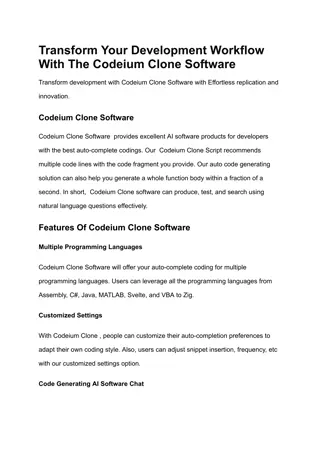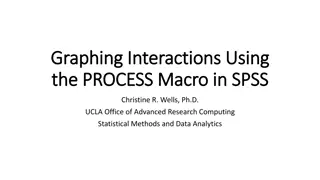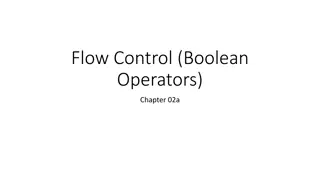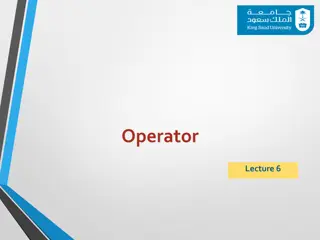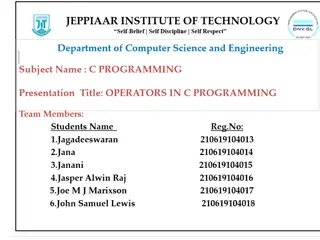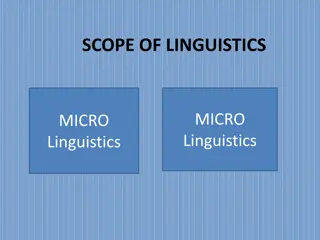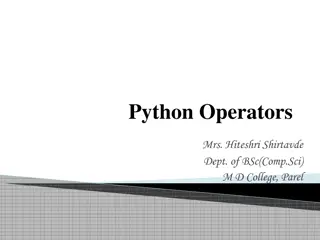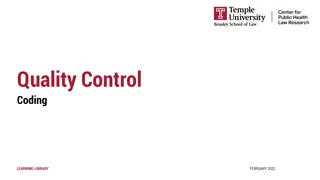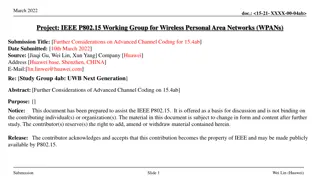Introduction to Operators in Macro Coding
Operators in macro coding are symbols that perform mathematical, comparison, or logical operations between two numbers or expressions. They follow a set order of precedence which determines the sequence of calculations. By understanding and utilizing operators effectively, you can control the flow and logic of your program, ensuring the desired outcomes. Learn about arithmetic operators like addition, subtraction, multiplication, and division, as well as the nuances of using parentheses to modify precedence. Mastering operators is fundamental to writing efficient and error-free macro code.
Uploaded on Feb 22, 2025 | 0 Views
Download Presentation

Please find below an Image/Link to download the presentation.
The content on the website is provided AS IS for your information and personal use only. It may not be sold, licensed, or shared on other websites without obtaining consent from the author.If you encounter any issues during the download, it is possible that the publisher has removed the file from their server.
You are allowed to download the files provided on this website for personal or commercial use, subject to the condition that they are used lawfully. All files are the property of their respective owners.
The content on the website is provided AS IS for your information and personal use only. It may not be sold, licensed, or shared on other websites without obtaining consent from the author.
E N D
Presentation Transcript
ITEC397 Macro Coding 06 OPERATORS
Operators 2 Operators perform mathematical functions, comparison functions, or logical operations between two numbers or numerical expressions within your program. Operators have orders of precedence that determine the order in which the calculations take place.
Operators 3 The order of precedence of the operators are shown in the following table from the top down
Operators 4 These orders of precedence can be changed by using parenthesis (brackets) within the formula, in the same way that you can in Excel formulas. The formulas within the innermost nested set of parentheses will always be evaluated first. The use of brackets to change the order of precedence can end up giving different results than you expect, so it is important to understand how they work. Examples: MsgBox (10 + 6) / 3 displays 5.3333 MsgBox 10 + 6 / 3 displays 12
Operators 5 Arithmetic Operators These are the operators that do the arithmetical work, such as plus (+), minus ( ), multiply(*), and divide (/). * Operator This signifies the multiplication of two numbers. MsgBox 6 * 3 Displays 18 The data type of the result is that of the most precise operand. Example, integer * double will give the result in double
Operators 6 + Operator This adds two numbers or expressions together. MsgBox 4 + 2 It displays 6 This operator can both add numbers and concatenate strings. String concatenation can cause confusion, so it is best to use the & operator for this purpose because you cannot always determine if string concatenation will occur with +. The numbers can be any numeric expressions. The data type of the result is that of the most precise operand.
Operators 7 + Operator Here are some general rules of addition and concatenation: Add if both operands are numeric. Concatenate if both operands are strings. Add if one operand is numeric and the other is a variant (not Null). Concatenate if one operand is a string and the other is a variant (not Null).
Operators 8 A Type Mismatch error occurs if one operand is numeric and the other is string, as shown here: MsgBox 1 + " Richard" Note this does not happen if you use the & operator to concatenate, as shown here: MsgBox 1 & " Richard Operator This subtracts one number from another or shows a negative value. MsgBox 6 4 It displays 2 MsgBox -5 It displays -5 The numbers can be any numeric expressions. The data type of the result is that of the most precise operand
Operators 9 / Operator This divides two numbers and returns a floating point result. MsgBox 6 / 3 It displays 2 If there were a remainder, it would be displayed as decimal places. The numbers can be any numeric expressions. The data type of the result is that of the most precise operand. \ Operator This divides two numbers and returns an integer result. Msgbox 6 \ 4 It displays 1 The numbers can be any numeric expressions. The data type of the result is Integer or Long.
Operators 10 ^ Operator This raises a number to the power of an exponent. MsgBox 2 ^ 3 It displays 8 (2 to the power of 3). The operands can be any numeric expression. Mod Operator This divides two numbers and returns only the remainder. MsgBox 6 Mod 4 It displays 2, which is the remainder of 6 divided by 4. This is often used when testing to see if a number is odd or even. If the modulus is True (nonzero) when divided by two, then the number is odd.
Comparison Operators 11 Comparison operators compare two expressions. MsgBox 3 > 1 This returns True because 3 is greater than 1. Comparison operators always return a Boolean value of True or False except when Null is included, in which case the result is always Null. If both expressions are numeric, then a numeric comparison is performed. If they are both string expressions, then a string comparison is performed. one is numeric (the variable is a numeric type containing a number) and one is a string (a variable containing a string of characters), then a Type Mismatch error will occur.
Comparison Operators 12 List of comparison operators
Concatenation Operator 13 This concatenates two operands together. MsgBox "Richard " & "Shepherd" This gives the result Richard Shepherd. Note that a space was left at the end of "Richard to give the space in the final string. You can also concatenate numbers and strings, but remember that the result will be a string. The following gives the result 12 Twelve : Msgbox 12 & " Twelve" VBA is allowing you to concatenate a number and a string as it is converting the number to a string first. The following gives the result 34, but as a string, not a number: Msgbox 3 & 4
Logical Operators 14 These perform a logical bit-by-bit conjunction on two expressions. They use pure binary math to decide the result. And Operator This works on the basis that both values have to be True (nonzero). The value of True in VBA is actually 1. The following will give the result False because both values have to be True for an overall True value when the And operator is used: Msgbox True And False
Logical Operators 15 And Operator Numbers can also be ANDed together. This is done on a binary basis. The top row of the following table represents the value of each binary bit going from bit 7 to bit 0. The two rows below it represent the binary equivalents of the numeric numbers on the right of the table (column n).
Logical Operators 16 And Operator The final row shows both the binary and numeric equivalents when the two numbers are Anded together. Each bit pair uses an And operator to achieve the final result on the bottom row. MsgBox 84 And 145 'This will give the result of 16.
Logical Operators 17 Not Operator The Not operator performs a logical Not on two numbers or expressions. It basically inverts the bits within a number. If a bit is set to 0, then it becomes 1; and if it is set to 1, it becomes 0. MsgBox Not (2 = 3) This will give the result True because 2 does not equal 3 (which is False), but the Not statement then inverts the bits and makes it True.
Logical Operators 18 Or Operator This works on the basis that either two values can be True (nonzero) or one can be True and the other False (zero). MsgBox True Or False It displays True MsgBox False Or False It displays False Numbers can be ORed together MsgBox 84 Or 145 It displays 213
Logical Operators 19 The Or operator is often used for masking purposes in graphics and also for combining two parameters. As it was discussed in the previous chapter, at the arguments part of the message box you can combine vbExclamation and vbYesNo in order to get the correct icon and the correct buttons on the message box. Also, you had seen the use of Or in an If statements If x = 1 Or y = 1 Then
Logical Operators 20 Xor Operator Xor is very similar to Or, except that True and True make False. Only True and False make True, but there must be one True and one False. Xor stands for Exclusive Or both values cannot both be True or False. The following gives the value True: MsgBox True Xor False It displays True MsgBox True Xor True It displays False
Logical Operators 21 Xor Operator Two numbers can be XORed MsgBox 84 Xor 145 It displays 197 This result has an interesting property. If you Xor the result with one of the numbers used, you will get the other number that was used to create the result. MsgBox 84 Xor 197 It displays 145 MsgBox 145 Xor 197 It displays 84
Logical Operators 22 This operator is often used in simple encryption routines. You use a string of random characters called KEY. The string you want to encrypt (The MESSAGE) is then Xored by KEY. This produces another apparently random string (CIPHER TEXT) with no discernible pattern in it (and patterns are what code breakers look for). To decrypt the string (CIPHER TEXT), all you have to do is Xor character by character against the KEY.
Logical Operators 23 Message Message Chiper Text XOR XOR Key Key
Other Operators 24 Is Operator Is compares two object reference variables to see if they are the same. The following returns True because the two expressions are both the same sheet1 is the same as sheet1: MsgBox Worksheets(1) Is Worksheets(1) The following returns False because the two expressions are not the same: MsgBox Worksheets(1) Is Worksheets(2) Here, sheet1 is not the same as sheet2 because it has a different name.
Other Operators 25 Like Operator Like compares two string expressions that are similar to each other to see if they match a pattern. They may have the first few characters the same or may simply be in uppercase and lowercase. Option Compare Text Sub test() MsgBox "RICHARD" Like "richard" End Sub If the Option Compare statement in declarations is set to Text (Case InSensitive), then this will return True. If it is set to Binary (Case Sensitive default setting), then it will return False. This works in the same way as the Compare parameter used in the Instr function in Chapter 5.
Other Operators 26 You can use wildcard characters. A ? denotes a single character and a * denotes a string of characters. It is exactly the same as doing a file search when you use wildcard characters. MsgBox "RICHARD" Like "ri?hard It displays True MsgBox "RICHARD" Like "ric* It displays True




